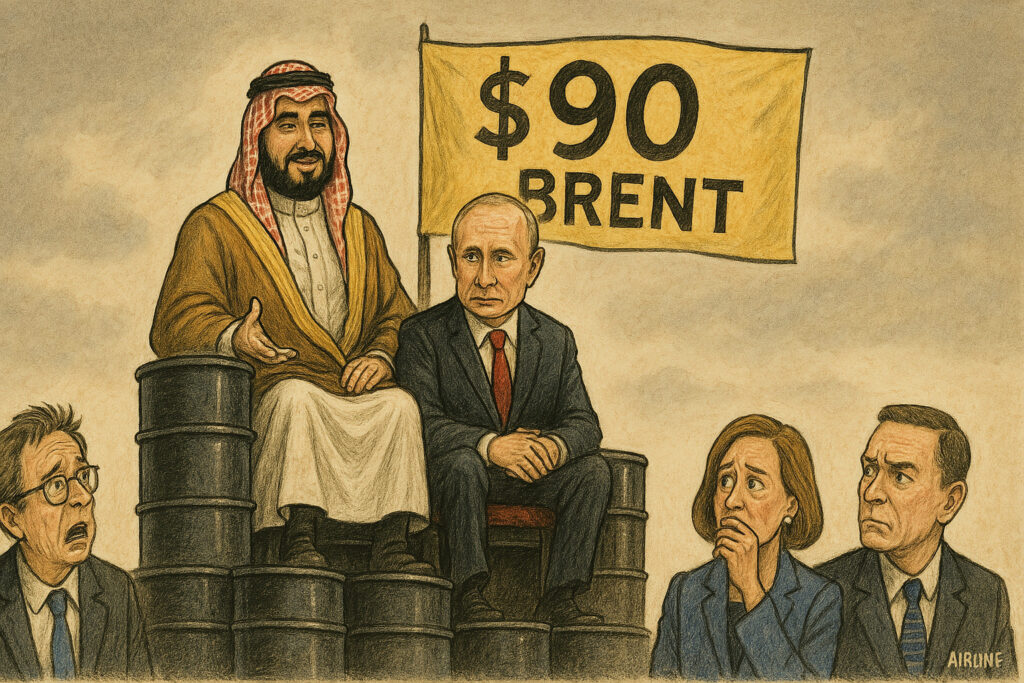Global energy markets were shaken on March 9, 2025, as the Organization of the Petroleum Exporting Countries and its allies, collectively known as OPEC+, announced the continuation of voluntary oil output cuts through the second quarter of 2025. The coalition’s decision, viewed as a strategic move to prop up oil prices amid fragile global demand, has sent Brent crude surging toward the key $90 per barrel mark.
As of market close on March 9:
- Brent Crude traded at $89.72, up 2.1%
- WTI Crude rose to $86.23, up 2.4%
- Energy stocks, including ExxonMobil (XOM) and Chevron (CVX), climbed 1.8% and 1.5% respectively
- The Energy Select Sector SPDR ETF (XLE) gained 2.2%
This move comes amid a complex backdrop of geopolitical tension, uncertain demand recovery in China, and tightening inventories in the U.S. and Europe.
OPEC+ Strategy: Tight Supply, Stable Price
At its monthly monitoring meeting, OPEC+ emphasized its commitment to market stability, citing “persistent macroeconomic uncertainty” and a “lack of consistent demand signals” from key economies. Saudi Arabia and Russia—de facto leaders of the group—confirmed they will extend their voluntary cuts of 1.5 million barrels per day (bpd) and 500,000 bpd respectively.
Total voluntary cuts among OPEC+ members now amount to approximately 2.2 million bpd, representing nearly 2% of global supply.
Prince Abdulaziz bin Salman, Saudi Arabia’s energy minister, stated:
“We must act preemptively. The goal is not price manipulation, but market equilibrium in the face of unpredictable demand.”
Russia’s Deputy Prime Minister Alexander Novak echoed this sentiment, highlighting ongoing Western sanctions and logistic constraints as factors behind Russia’s decision to maintain lower export volumes.
Market Reaction and Investor Sentiment
Brent crude’s approach to the psychologically significant $90 threshold has reignited bullish sentiment in the oil market. Traders and institutional investors are reassessing their short-term energy exposure, and options markets saw a spike in bullish call activity centered on Brent futures.
Goldman Sachs, in a note to clients, raised its Q2 Brent target from $88 to $92, citing “unexpectedly unified OPEC+ cohesion” and “resilient core demand.”
Meanwhile, hedge funds increased their net long positions in crude oil by 12% in the week ending March 8, according to data from the Commodity Futures Trading Commission (CFTC).
Macro Landscape: Tight Inventories and Geopolitical Risk
Beyond the OPEC+ decision, several factors have contributed to the recent strength in oil:
- U.S. crude inventories fell by 4.1 million barrels last week, according to the EIA, marking the largest draw in two months.
- Refinery utilization rates have risen to 89.4%, suggesting early signs of stronger seasonal demand.
- Geopolitical instability in the Middle East continues to pose supply-side risks, particularly with renewed tension in the Strait of Hormuz.
In China, signs of a tepid recovery following Lunar New Year holidays have contributed to mixed demand signals. Still, industrial activity has picked up, with imports of crude oil rising 5.2% year-over-year in February.
Sector Impact: Winners and Risks
Energy Stocks Surge
- ExxonMobil (XOM): +1.8% to $122.45
- Chevron (CVX): +1.5% to $160.32
- Halliburton (HAL): +2.6% to $37.18
Oilfield services and integrated energy companies are reaping the rewards of higher price stability, while upstream-focused firms may see enhanced profit margins.
Airlines and Industrials Under Pressure
Conversely, energy-intensive sectors like airlines and heavy industry may feel margin pressures:
- Delta Air Lines (DAL): -1.1%
- United Airlines (UAL): -1.3%
- Caterpillar (CAT): -0.8%
Inflation Concerns Reignited
With crude nearing $90, inflation-sensitive assets are reacting. Bond yields edged up as investors priced in a potentially hawkish Fed if energy prices translate into broader consumer price increases.
Analyst Insights: Is $100 Oil on the Horizon?
The million-dollar question: will Brent cross $100 in 2025?
Several analysts argue it’s possible if:
- Chinese demand rebounds faster than expected
- Geopolitical disruptions worsen
- U.S. shale growth fails to compensate for global tightness
Morgan Stanley’s energy desk notes:
“While $100 oil isn’t our base case, we’re now assigning a 35% probability for Brent to hit triple digits by summer 2025.”
On the other hand, some caution that any demand shock—such as a recession in Europe or deflationary spiral in China—could rapidly pull prices back below $80.
What Could Derail the Rally?
Despite bullish momentum, risks remain:
- U.S. Strategic Petroleum Reserve (SPR) releases could cap prices
- Iranian oil supply may increase if diplomatic progress continues
- Dollar strength could weigh on commodity prices globally
Moreover, higher oil prices may spur U.S. shale producers to ramp up production. So far, rig counts have remained relatively stable, but that could change quickly with Brent approaching $90.
Looking Ahead
Oil markets are entering a delicate phase. The extension of OPEC+ cuts shows strong discipline among producers, but also raises the stakes. Should global demand weaken or financial conditions tighten further, the market could pivot rapidly.
Investors should monitor:
- OPEC+ compliance rates (historically variable)
- Weekly EIA/U.S. inventory data
- Chinese manufacturing and services PMI
- Currency moves (especially USD/CNY and USD/EUR)
As of now, the bias is upward—but volatility is likely to return with any sign of macro weakness.
Conclusion
March 9, 2025, marked a pivotal moment in global energy markets. OPEC+’s decision to maintain deep output cuts has emboldened bulls and rekindled inflationary concerns. With Brent inching toward $90 per barrel, traders and policymakers alike must now grapple with the implications of sustained high energy prices.
Whether the market sees a sustained breakout—or a sharp reversal—will hinge on the delicate interplay between supply discipline, macro demand, and geopolitical stability.
